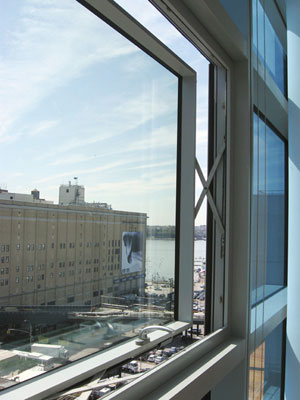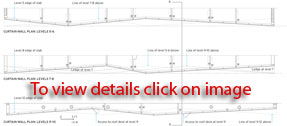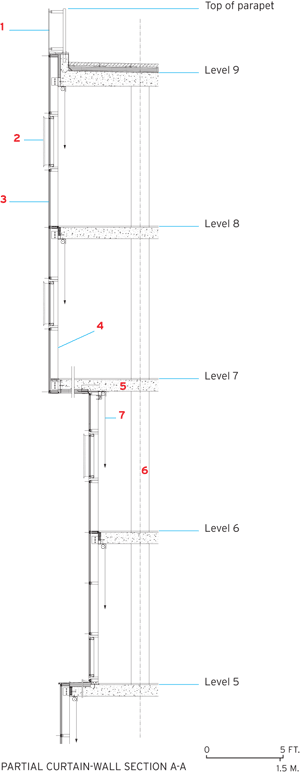Transparency: Literal and Sustainable
Don't confuse the high-performance glass facades of these new buildings with textbook examples from early Modernism
![]() Continuing Education
Continuing Education
Use the following learning objectives to focus your study while reading this month’s Continuing Education article.
Learning Objectives - After reading this article, you will be able to:
- Explain the physical properties of glass that affect transparency and environmental performance.
- Identify recent technical advances in glass production.
- Describe facade design strategies that can optimize transparency, energy efficiency, and daylighting.
- Identify analysis and simulation tools used in facade and daylighting design.
In 1929, when Le Corbusier set about designing the double-skinned glass curtain wall for the Cité de Refuge in Paris, he had no facade consultant to write the glass specification. It wouldn't have mattered anyway, since the spec would have been one word: clear. Two panes of clear glass defined a cavity, in which Le Corbusier had planned to supply tempered air with a mechanical ventilation system. Think of it as transparent insulation. However, the client eliminated the double skin, kept the single glass layer sealed tight, and instead fed the air directly into the building. With no return-air path, it didn't work. And the single layer of glass, totally exposed to the sun, failed miserably. Years later, the architect added a brise-soleil to cut the solar heat gain and prevent occupants from overheating.
"Le Corbusier didn't have access to [software like] EnergyPlus," jokes facade consultant George Loisos, AIA. Loisos's comments are part of his explanation of the myriad tools for specialized analysis he and his colleagues at Berkeley, California−based Loisos + Ubbelohde (L+U) have applied to building design. EnergyPlus-the U.S. Department of Energy's free software for modeling high-performance green buildings-is only one of those many tools.
Loisos's partner, Susan Ubbelohde, likens the firm's energy modeling and daylighting work on a new hospital in Abu Dhabi for the Cleveland Clinic, designed by HDR Architecture, to a technological update of Le Corbusier's approach. "The building science and energy worlds are quite worried about the glass building syndrome," she says, adding that architects have moved beyond the glass box and are becoming more interested in complex and layered facade systems.
History demonstrates that, at least since Joseph Paxton, building designers have been fascinated with transparency. What's changed since Paxton built the Crystal Palace in London in 1851 and Modernism emerged in the early 20th century is how architects and their consultants achieve transparency and how they measure success. As glass has evolved, so has its expression. The Cleveland Clinic exemplifies this shift as its 360-bed patient tower appears firmly rooted in the Bauhaus tradition with spandrel panels articulating each slab level, a continuous glazing system wrapping the corners, and with its diagrid curtain-wall system explicitly revealed. And yet, this reading relates only to the building's structural and envelope systems, not to an understanding of the intangible performance of those systems.
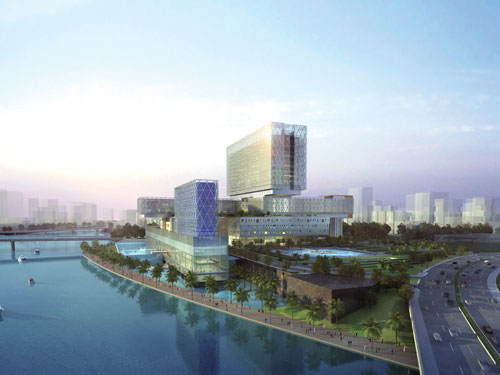 |
|
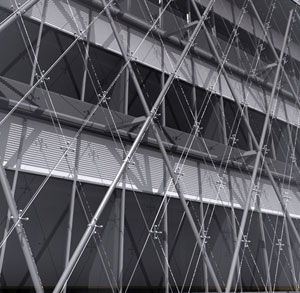 |
A double-skinned curtain Images courtesy HDR and |
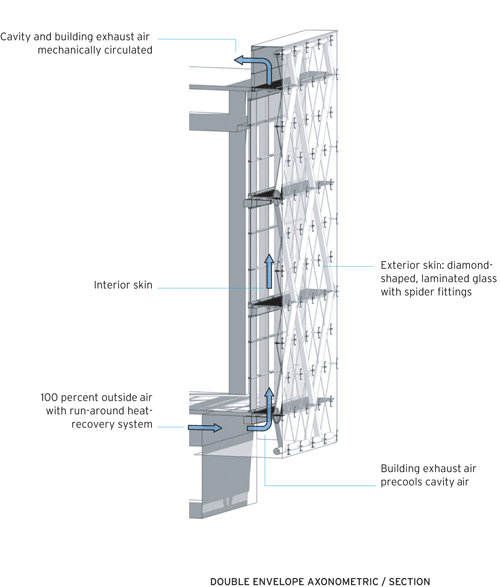 |
|
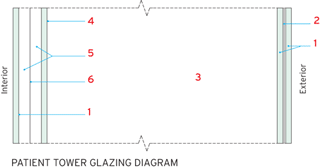 |
1.Low-iron glass with  |
Glass in the desert
Creating a high-performing, but transparent, building requires coordination among a broad range of conventional design fields, including facade design, mechanical engineering, lighting design, thermal analysis, and architecture. The parameters that determine occupant comfort and performance-solar heat gain coefficients, daylight factor, visible light transmittance, U-values, and reflectivity-are highly interdependent and never considered in a linear fashion. An integrated design process is more or less mandatory.
For the Cleveland Clinic, slated to open in 2012, the project team settled on the double skin because it satisfied the client's desire for transparency, clarity of design, and optimization of daylight. At the same time, the strategy responded to concerns about glare control and maintenance (exterior sunshades or louvers in Abu Dhabi can present problems, particularly during frequent dust storms). Ted Jacob, whose Oakland, California−based Ted Jacob Engineering Group led the project's mechanical design, says a conventional approach to a double skin relying on operable windows and a natural stack effect wouldn't work in Abu Dhabi's extreme climate.
Since a hospital's clinical areas require full outside air, even the slightest reduction in the ventilation air's temperature prior to passing it over the air-handling unit's cooling coils can amount to significant energy savings. The design temperature Jacob used for Abu Dhabi was 115 degrees, with a patient-room supply-air temperature of 55 degrees, and exhaust air at around 75 degrees after picking up solar, occupant, and equipment loads. Jacob's design exploits the 40-degree difference between the outside and exhaust air by passing recovered exhaust air in pipes through the intakes for the hotter, more humid outside air. The exhaust air warms to about 96 degrees and is then released into the curtain-wall cavity, where it picks up more heat and is vented through louvers at the roof. In conventional practice, that exhaust air would be dumped, but Jacob wrings one more use out of it to provide an invisible layer of insulation between the outer and inner curtain-wall skins.
Solar heat gain and U-values
The solar load on a facade has two primary modes of transfer to the building's interior: radiation and conduction. Radiation is the heat passing through the building envelope in the form of ultraviolet, visible, and infrared light, while conduction occurs from hot to cold surfaces and through air. The solar heat gain coefficient (SHGC), expressed as a percentage, measures the transmission of heat directly through the glass. Glass with a SHGC of 0.30 blocks 70 percent of the solar heat load. The shading coefficient (SC) is more or less the same idea, only it expresses performance against a benchmark of a single 1â„8-inch sheet of clear glass set as 1.0. A SHGC of 0.30 would roughly equate to a SC of 0.35. The SHGC directly affects a glass's U-value, a measure of conductive heat transfer over a given area under standard conditions. A low U-value means very little heat is conducted, either gained or lost, through the glazing. Glass manufacturers provide what they call "center of pane" U-values that address the free-hanging sheet of glass; these are combined into the envelope construction to establish an assembly's overall U-value. The inverse to this is the R-value, a measure of the building element's thermal resistance, or its effectiveness as an insulator.
After first reducing internal loads, designers set about minimizing radiated and conducted loads on the facade. The American Society of Heating Refrigerating and Air-Conditioning Engineers (ASHRAE) publishes data on expected solar gain loads for nearly every climate on the planet. These data set the baseline for sizing a mechanical system, but cooling alone won't shield a building from the effects of the harsh Abu Dhabi sunlight. Reducing glazed surfaces, increasing external reflectivity, providing shading devices, and introducing a low-emissivity (low-E) coating can all limit radiation. For the clinic, the architects introduced an opaque spandrel element on the inner glass skin, in addition to coatings, to reduce radiated heat gain. "The air cavity in the double skin removes some of the conductive heat from the outer skin through a convective means," says Warren Cheng, a project engineer with Ted Jacob. "And because the inner skin is a double pane with an air gap, it's even less sensitive to conductive gain."
Visually, the clinic's facade has two layers, but in reality it is composed of nine. From the exterior working in there are two layers of low-iron glass laminated with a reflective film and applied with an antireflective coating; a nearly 5-foot air gap; a layer of clear glass with a low-E coating; a half-inch argon-filled gap with a suspended coated film; and a final layer of low-iron glass. The outer glass has an SHGC of 0.51 and a visible light transmittance (VLT) of 74 percent, while the inner glass has an SHGC of 0.186 and a VLT of 42 percent.
L+U modeled the glass construction in EnergyPlus to measure the thermal performance. "About half of the solar heat gain is short-wave infrared, which is basically waste heat," says Loisos. "With the coatings, we filter all of the short-wave infrared and nearly all of the ultraviolet." The first layer of reflective film reflects ultraviolet and infrared radiation at the outer skin, thus a smaller amount of heat is absorbed and reradiated by the glass into the cavity, while the spectrally selective suspended film in the inner skin reflects a significant amount of what remains. Both films are clear and don't compromise the envelope's transparency. Coupled with the novel heat-recovery system, the facade design helped the building improve on ASHRAE 90.1-2004 standard by 14 percent.
Of course, not all project budgets have room for a double skin. An increasingly common approach to all-glass facades is to use multiple types of glass with varying performance characteristics. Such a strategy was employed by New York City−based Audrey Matlock, AIA, for the design of the Chelsea Modern, a 47-unit residential building on a tight midblock Manhattan site. She developed the primary facade as a series of stacked bands, accentuated with layers of clear and blue glass, that evoke a sense of lateral movement across the elevation. Jeffrey Ng, AIA, an architect and facade consultant in the New York office of Thornton Tomasetti, says although site constraints permitted only one all-glass facade, the project's thermal design benefited greatly from the balance of glass types. The clear glass has an SHGC of 0.38 and covers 30 percent of the main facade, while the blue-tinted glass has an SHGC of 0.28 and covers the rest. It follows that the actual performance of the total facade lies somewhere between the two.
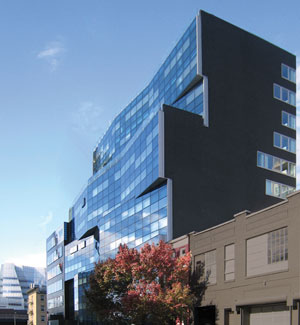
Images: courtesy Audrey Matlock (photos, top, and drawings); Thornton Tomasetti (photo, bottom) |
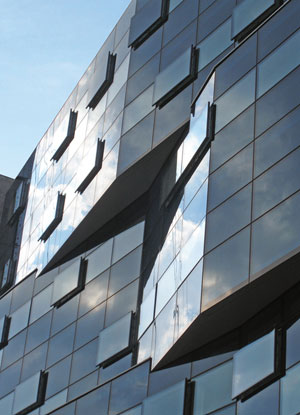
|
Daylighting, glare, and reflectivity
Good thermal performance does not automatically translate into good daylighting performance. Concurrent with its energy studies for the Cleveland Clinic, L+U developed a model with the software Radiance (available for free at http://radsite.lbl.gov) to measure illuminance, or the density of luminous power, across the plan and section of a typical patient room. They also looked at daylight factor (DF), which describes the ratio of outside illuminance to inside illuminance. The calculation is based on an overcast, or "design sky," but designers find it helpful for gauging the performance of a building's envelope, and generally target a DF between 2 and 5 percent.
Ubbelohde says L+U tests mainly for best and worst cases, pinpointing when sunlight becomes too much of a contrast with the room interior and when automatic blinds may be needed to prevent glare. The firm tries to minimize reliance on blinds, according to Ubbelohde, since it can detract from the transparency of the facade. For the clinic, L+U also analyzed the reflectance of the exterior skin to gauge how it will read in full sun and whether it could distract drivers in passing cars.
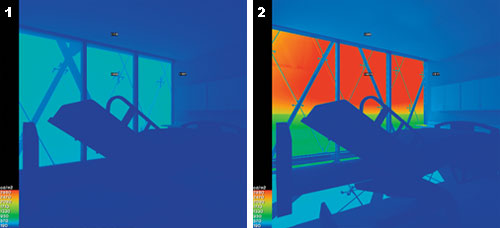 |
|
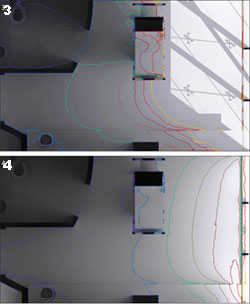 |
The facade consultants for the Cleveland Clinic project looked at patient-room daylighting conditions with Radiance. As part of this analysis, they examined the effect of various sky conditions at different times of the day and year. Shown here are luminance studies (1, 2) and illuminance studies (3, 4) for March Images courtesy HDR and Loisos + Ubbelohde |
Â
Optimization of characteristics like SHGC, VLT, and reflectance requires not only extensive simulation and careful study, but also a good sensibility for daylighting design, according to Tomasetti's Ng. "You have to understand the psychology of the eye, which sees 50 to 60 percent VLT as transparent," he says. The Chelsea Modern's blue glass has a VLT of 31 percent, but at the vision plane, with the clear glass, it's closer to 70 percent. "An architect has to become engaged in modulating this concept of absolute transparency," he says.
Transparency and technology
The Modernist obsession with glass put pressure on industry to improve the material's performance. One of the first responses was the bronze, titanium, and gold mirror glasses developed in the 1960s and '70s. Mirror glass is great in terms of reducing solar loads, with an SHGC in the 0.20 to 0.30 range or lower, but awful for daylighting, with a VLT often less than 10 percent. In the 1980s, low-E coatings were introduced to reduce reflectivity and improve VLT while still controlling the SHGC. These coatings have evolved to the point where, as with the Cleveland Clinic, an architect can specify glass with a VLT in the 40 to 50 percent range without significantly increasing solar heat gain.
Only a short time ago, glass with a VLT greater than 40 percent had a minimum SHGC of 0.40. But over the past decade, manufacturers have been able to reduce the SHGC first to 0.35, and then down to 0.30. These numbers correspond to glasses that appear clear, as opposed to green, gray, or blue/green. Low-iron glass typically has less of a greenish tint than float glass.
Many manufacturers also produce fritted glazing. This type of glass includes a silk-screened ceramic pattern that helps reduce glare and the SHGC, even if only by a small amount. Although frit is not new, architects are finding new ways to use it, such as in Gehry Partners' frosted white InterActiveCorp building, not far from the Chelsea Modern, on New York City's west side [Architectural Record, October 2007, page 114].
 |
The cladding strategy for Block 21, a hotel and condominium project under construction in Austin, Texas, includes a glass and aluminum curtain wall with large spandrel panels for the building's lower floors. The tower's upper levels have larger expanses of clear glass balanced with areas of higher reflectivity glass. Images courtesy Andersson Wise Architects and BOKA Powell |
Â

Â
Another option is electrochromic glazing, otherwise known as switchable glass. Dane Sanders, an engineer with Boulder, Colorado−based daylighting consultant Clanton and Associates, originally proposed electrochromic glazing for Block 21, a 35-story hotel and condominium project under construction in Austin, Texas. The glass appears clear, but becomes darker when exposed to sun, reducing VLT but improving thermal performance by as much as 80 percent. But "it's expensive, and it's another thing you have to supply with electricity," says Sanders, which perhaps explains why it is not part of the building's final design. Instead, the Block 21 project team, which includes Andersson Wise Architects and BOKA Powell as architect of record, focused on reducing east and west exposures, introducing a more conventional glass-and-aluminum curtain wall with large spandrels for the hotel. Then, for the condominium portion at the top of the tower, the designers chose larger expanses of recessed, clearer glass balanced with areas of higher reflectivity glass. The overall effect is glassy, but the variety of constructions should ensure a high enough level of performance to help the project achieve its LEED Platinum goal.
Architecture by numbers
Building designers now have largely invisible methods for dealing with environmental conditions that were only intuitively understood by the early Modernists. And glass and coatings manufacturers have quantitative methods for describing product performance. They feed the numerical specifications of their products into the International Glazing Database, which itself is embedded in the Optics 5 and Window 6 software developed by the Lawrence Berkeley National Laboratory (both free at http://windows.lbl.gov). Optics 5 allows designers to build their own glass type, specifying nearly every property, which then can be used to assemble a complete glazed unit-frame and all-in Window 6. These programs give designers precise performance data to feed directly into modeling software such as EnergyPlus or Radiance. In theory, any glass type is possible. Ubbelohde says L+U has often created an ideal glass and then asked a manufacturer to make it. "We're not bound by what's in Window 6," she says. "It's only the laws of physics holding us back." Le Corbusier's original Cité de Refuge may not have been entirely possible in the 1930s, but he imagined it anyway.

